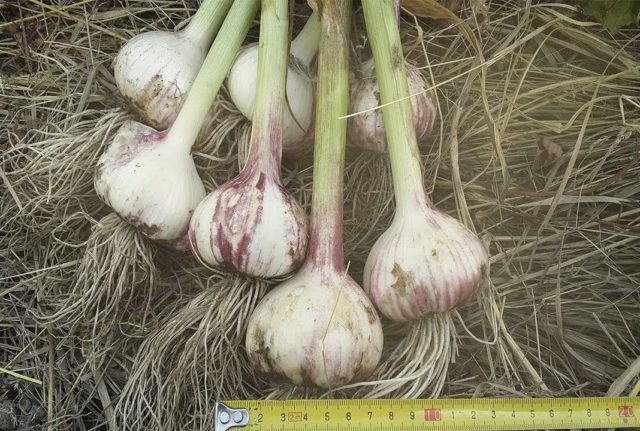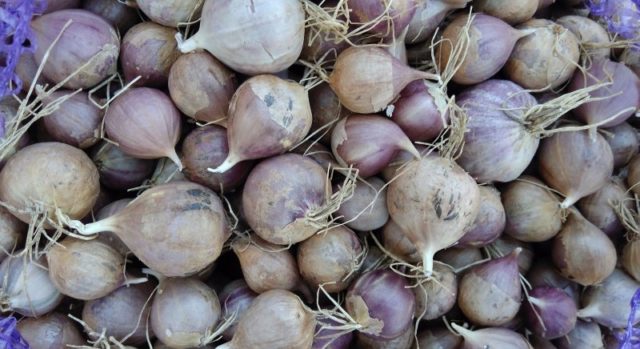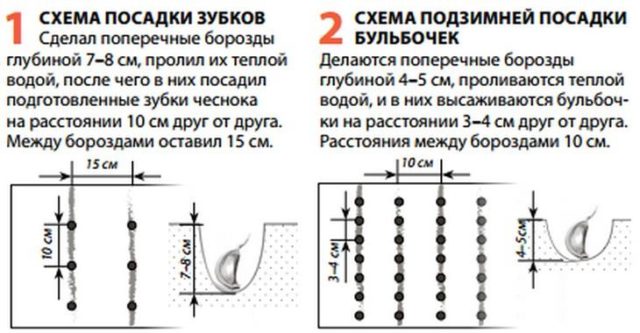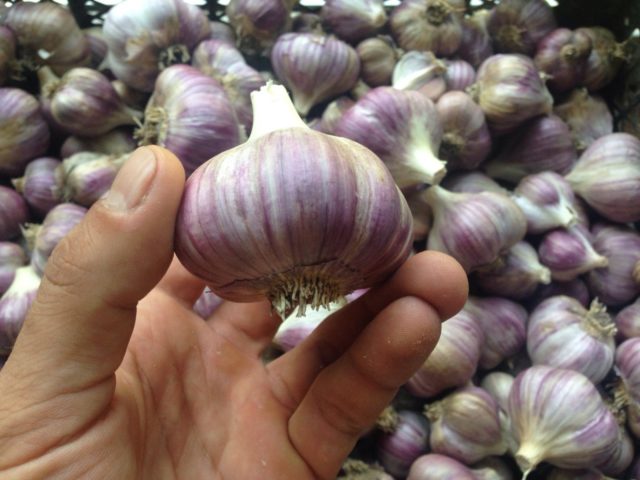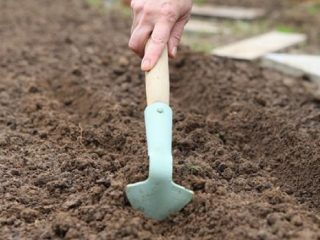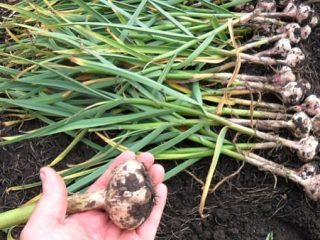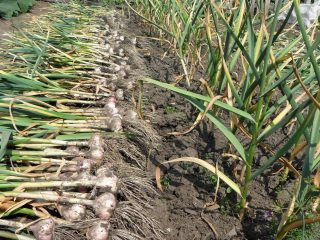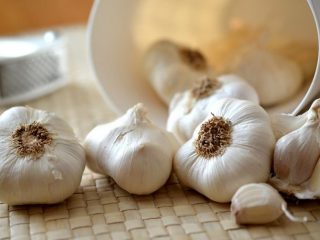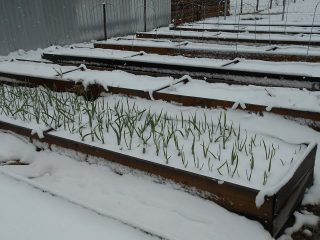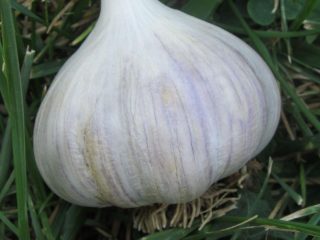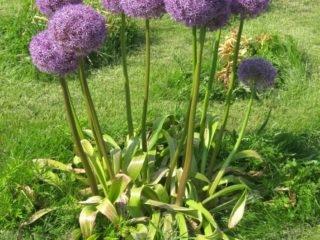Content
Lyubasha garlic is an unpretentious winter variety that is distinguished by its large heads. It is propagated by cloves, bulblets and single-claws. The high-yielding variety is drought-resistant and is little affected by fungal diseases inherent to the species.
History of variety selection
Winter garlic Lyubasha was bred by Ukrainian gardener and vegetable grower from the Zaporozhye region I.I. Zakharenko, he was tested in 2005-2007. It has spread in Russia due to its high yield and unpretentiousness to weather conditions. The new variety has absorbed the best properties of the winter subspecies.
Description of the garlic variety Lyubasha
The Lyubasha variety surprises with its large fruit due to its powerful root system. Each specimen has at least 150 roots, which exceeds other known varieties. The green above-ground part of the plant rises to 1-1.2 m. Under good agrotechnical conditions it reaches 1.5 m. The width of dense erect leaves with a light waxy coating is 2-3 cm, length - 45-50 cm.
Specimens growing from cloves shoot out arrows in the south at the end of May, in the middle zone - in June. The arrows are tall, up to 1-1.1 m. The inflorescence creates from 40-60 to 120 aerial bulbs, each with an average weight of 15 g. There are large bulblets - 20-30 g. Sometimes, when they are sown, arrows are also formed. The germination rate of aerial bulbs with a diameter of 4-7 mm is 60-70%.
The round-flat heads of winter garlic of the Lyubasha variety are striking in size: on average, the diameter reaches 5.5-6.5 cm, weight - 65-80 g. There are 2 times larger ones, with a weight of 100 to 150 g. A head of the variety has been recorded weighing 375 d. The bulbs are densely covered with white-pink husk, usually of a pale shade. The color depends on the minerals that the areas are rich in: there are heads of Lyubasha garlic with intense pink-purple streaks. Well-developed bulbs are divided into 6-7 large cloves. Ideally there should be at least 4 slices. A lower number indicates the degeneration of this batch of garlic.
The average weight of slices of the Lyubasha variety is 6-17 g. Dense, crispy flesh of a white-cream color. The taste is sharp, piquant, the aroma is expected, rich in specific essential oils, which are contained in 100 g up to 0.4%. High level of ascorbic acid – 34 mg, 43% dry matter, 0.3% allicin, 17.0 mcg selenium. The bulbs of Lyubasha's harvested garlic are shelf-stable and can be stored for 10 months without losing their taste. Fresh slices are used as a seasoning for hot dishes, for marinades and canned food.
Characteristics of garlic variety Lyubasha
A variety with excellent qualities is grown on private plots and on plantations on an industrial scale.
Productivity of winter garlic Lyubasha
The mid-season variety ripens 3 months after spring germination. Bulbs are dug in different regions from the end of June or in July. From 1 sq. m get 1.5-3 kg. In the fields of agricultural enterprises with regular watering and fertilizing, Lyubasha garlic shows productivity from 1 hectare to 35 c. The fee depends on:
- on the nutritional value of the soil;
- its moistening during periods of drought;
- application of fertilizers.
Due to its developed root system, garlic adapts well to different types of soil, as well as climatic conditions. Shows excellent productivity in dry years. In a well-mulched area, it safely tolerates frosty winters even without snow cover. The genetic properties of the Lyubasha variety to resist diseases play an important role. Timely removal of arrows is displayed on the yield and weight of the heads. They are torn off when they reach a length of 10 cm.
Resistance to diseases and pests
Garlic of folk selection is resistant to fusarium. Pests also rarely attack the plant. If another variety is sick nearby, preventive procedures are carried out.
Advantages and disadvantages of the variety
According to reviews, the Lyubasha garlic variety has many advantages:
- high productivity;
- early maturation;
- frost resistance;
- drought resistance;
- adaptability to soils;
- low susceptibility to diseases.
Gardeners do not find any disadvantages in the Lyubasha variety.
How to plant garlic Lyubasha
The quality of the resulting heads or the initial successful stage of its reproduction also depends on the implementation of planting rules.
Landing dates
When planting winter varieties of garlic, it is important to at least roughly follow the long-term weather forecast when frost sets in. The cloves must acclimatize in the soil before the onset of cold weather, this takes up to 16-20 days. This is the best time to plant winter garlic. If the slices are planted long before frost, they germinate and produce above-ground seedlings, which will certainly suffer in winter. Planting too late also threatens that the cloves will not take root and may die. In the southern regions, winter varieties are planted in October-November, in the middle zone - from the end of September to October 10. The soil temperature should be between 10-15 °C.
Preparing the bed
On the plot for Lyubasha’s garlic, a spacious place is allocated, illuminated by the sun, away from the shade of trees. A lowland or a small lonely hill is also not suitable. In the first case, water accumulates in such an area after snow melts and rains, which will lead to the death of the plantings. On a hill, snow is blown away by the wind, which further lowers the temperature and freezes the ground deeper.
2-3 weeks before planting winter garlic Lyubasha, the area is plowed to a depth of 30 cm, fertilized with minerals based on potassium and phosphorus or compost, rotted humus, but not fresh manure.
Planting garlic
During the days remaining before the cloves or bulbs are planted, the furrows are watered 2-3 times. Watering helps compact the soil. If garlic is planted in soil that is too loose, the cloves will sink down and make it difficult for them to germinate. The day before planting, the cloves and aerial bulbs are soaked for half an hour in a pink solution of potassium permanganate for disinfection. The remaining time is spent drying them.
Planting scheme for winter garlic:
- the grooves are deepened to 7-8 cm;
- the interval between rows of the large-fruited Lyubasha variety is 40 cm;
- the distance between the holes is 10 cm.
Wood ash is poured into the grooves. After deepening the cloves, they are sprinkled with soil and mulched with sawdust, peat, and hay.
A decrease in quantity is a signal that this batch of garlic is degenerating. Also, do not plant germinating segments.
Growing garlic Lyubasha
With the onset of frost, the area is covered with leaves or spruce branches. After the snow melts, the mulch is removed. The soil is regularly loosened and weeded weeds, on which pests and pathogens can multiply. If there are hot days without precipitation, water the garlic 2-3 times a week. 14-16 days before collecting the heads, watering is stopped. Shooting begins at the end of May. A few inflorescences are left for propagation, others are plucked off.
In spring, the crop is fertilized with 20 g of urea per bucket of water. Chicken manure and minerals are also used. When the leaves turn yellow, the plants are supported with ammonia, hydrogen peroxide, and yeast.
Harvest and storage
Garlic is harvested in the 1st or 2nd decade of July. The heads are carefully dug up, left to dry for 1-2 hours and cleared of soil. The bulbs are dried under a canopy for 1-2 weeks, then the stems are cut off and placed in boxes for storage in the basement.
Methods for propagating garlic
The Lyubasha variety is propagated:
- the teeth into which the head is divided;
- single-toothed ones that grew from air bulbs;
- aerial bulbs from a mature inflorescence.
Any planting material for winter garlic is planted only in the fall. The only difference is in the planting depth of the slices and bulbs. The latter are sown to a depth of 5 cm. Before planting, all seeds are disinfected.
Constant, year after year, reproduction of garlic into cloves from large heads leads to degeneration of the species. Therefore, those gardeners who are serious about working on the land are sure to leave a few arrows with seeds for further propagation.
Diseases and pests, methods of control and prevention
As noted in the reviews, Lyubasha’s garlic is not affected by fusarium, but can become infected with other fungal diseases during the growing season. For prevention, grown rows are sprayed with the microbiological agent “Fitosporin” or other fungicides. Plants affected by viruses are removed.
Pests are repelled with ammonia during foliar feeding, and insecticides are used. The best prevention against nematodes and mites is pre-sowing soaking of the segments.
Conclusion
Lyubasha garlic is now the most productive winter variety. Planted in time, mulched for the winter, watered in the summer and protected by preventative measures from pests and diseases, garlic will delight you with a rich harvest of large heads in July.

